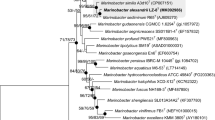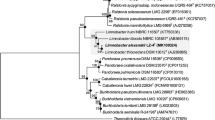Abstract
Marine phycosphere harbors unique cross-kingdom associations with enormous ecological significance in aquatic ecosystems as well as relevance for algal biotechnology industry. During our investigating the microbial composition and bioactivity of marine phycosphere microbiota (PM), a novel lightly yellowish and versatile bacterium designated strain AM1-D1T was isolated from cultivable PM of marine dinoflagellate Alexandrium minutum amtk4 that produces high levels of paralytic shellfish poisoning toxins (PSTs). Strain AM1-D1T demonstrates notable bioflocculanting bioactivity with bacterial exopolysaccharides (EPS), and microalgae growth-promoting (MGP) potential toward its algal host. Phylogenetic analysis based on 16S rRNA gene sequences revealed that strain AM1-D1T was affiliated to the members of genus Sulfitobacter within the family Rhodobacteraceae, showing the highest sequence similarity of 97.9% with Sulfitobacter noctilucae NB-68T, and below 97.8% with other type strains. The complete genome of strain AM1-D1T consisted of a circular 3.84-Mb chromosome and five circular plasmids (185, 95, 15, 205 and 348 Kb, respectively) with the G+C content of 64.6%. Low values obtained by phylogenomic calculations on the average nucleotide identity (ANI, 77.2%), average amino acid identity (AAI, 74.7%) and digital DNA-DNA hybridization (dDDH, 18.6%) unequivocally separated strain AM1-D1T from its closest relative. The main polar lipids were identified as phosphatidylglycerol, phosphatidylethanolamine, phosphatidylcholine, diphosphatidylglycerol, one unidentified phospholipid and one unidentified lipid. The predominant fatty acids (> 10%) were C18:1 ω7c, C19:0 cyclo ω8c and C16:0. The respiratory quinone was Q-10. The genome of strain AM1-D1T was predicted to encode series of gene clusters responsible for sulfur oxidation (sox) and utilization of dissolved organic sulfur exometabolites from marine dinoflagellates, taurine (tau) and dimethylsulfoniopropionate (DMSP) (dmd), as well as supplementary vitamin B12 (cob), photosynthesis carotenoids (crt) which are pivotal components during algae-bacteria interactions. Based on the evidences by the polyphasic characterizations, strain AM1-D1T represents a novel species of the genus Sulfitobacter, for which the name Sulfitobacter alexandrii sp. nov. is proposed. The type strain is AM1-D1T (= CCTCC 2017277T = KCTC 62491T).








Similar content being viewed by others
Availability of data and materials
Strain AM1-D1T has been deposited in two independent international culture centers (CCTCC in China, and KCTC in South Korea) with the deposition no. CCTCC AB 201696 and KCTC 52626, respectively.
Abbreviations
- AAI:
-
Average amino acid identity
- ABI:
-
Algae-bacteria interactions
- ANI:
-
Average nucleotide identity
- MGPB:
-
Microalgae growth-promoting bacteria
- dDDH:
-
Digital DNA–DNA hybridization
- DPG:
-
Diphosphatidylglycerol
- DMSP:
-
Dimethylsulfoniopropionate
- EPS:
-
Exopolysaccharides
- HAB:
-
Harmful algal blooms
- MA:
-
Marine agar
- MB:
-
Marine broth
- ML:
-
Maximum likelihood
- MP:
-
Maximum parsimony
- NJ:
-
Neighbour joining
- PC:
-
Phosphatidylcholine
- PE:
-
Phosphatidylethanolamine
- PG:
-
Phosphatidylglycerol
- PHB:
-
Polyhydroxybutyrate
- PL:
-
Phospholipids
- PM:
-
Phycosphere microbiota
- PMP:
-
Phycosphere microbiome project
- UBCG:
-
Up-to-date bacterial core gene
References
Amin SA, Parker MS, Armbrust EV (2012) Interactions between diatoms and bacteria. Microbiol Mol Biol Rev 76:667–684
Buchan A, González JM, Moran MA (2005) Overview of the marine Roseobacter lineage. Appl Environ Microbiol 71(10):5665–5677
Cho JC, Vergin KL, Morris RM, Giovannoni SJ (2004) Lentisphaera araneosa gen. nov., sp. nov, a transparent exopolymer producing marine bacterium, and the description of a novel bacterial phylum, Lentisphaerae. Environ Microbiol 6:611–621
Chou HN, Chen YM, Chen CY (2004) Variety of PSP toxins in four culture strains of Alexandrium minutum collected from southern Taiwan. Toxicon 43:337–340
Duan YH, Jiang ZW, Wu Z, Sheng Z, Yang X, Sun JY, Zhang XL (2020) Limnobacter alexandrii sp. nov., a thiosulfate-oxidizing, heterotrophic and EPS-bearing Burkholderiaceae isolated from cultivable phycosphere microbiota of toxic Alexandrium catenella LZT09. Antonie Van Leeuwenhoek 113:1689–1698
Fukui Y, Abe M, Kobayashi M, Satomi M (2015) Sulfitobacter pacificus sp. nov., isolated from the red alga Pyropia yezoensis. Antonie Van Leeuwenhoek 107:1155–1163
Fukui Y, Abe M, Kobayashi M, Shimada Y, Saito H, Oikawa H, Yano Y, Satomi M (2014) Sulfitobacter porphyrae sp. nov., isolated from the red alga Porphyra yezoensis. Int J Syst Evol Microbiol 64:438–443
Gonzalez LE, Bashan Y (2000) Increased growth of the microalga chlorella vulgaris when coimmobilized and cocultured in alginate beads with the plant-growth-promoting bacterium Azospirillum brasilense. Appl Environ Microbiol 66:1527–1531
Hiraishi A, Ueda Y, Ishihara J, Mori T (1996) Comparative lipoquinone analysis of influent sewage and activated sludge by high-performance liquid chromatography and photodiode array detection. J Gen Appl Microbiol 42:457–469
Hong Z, Lai Q, Luo Q, Jiang S, Zhu R, Liang J, Gao Y (2015) Sulfitobacter pseudonitzschiae sp. nov., isolated from the toxic marine diatom Pseudo-nitzschia multiseries. Int J Syst Evol Microbiol 65:95–100
Ivanova EP, Gorshkova NM, Sawabe T, Zhukova NV, Hayashi K, Kurilenko VV, Alexeeva Y, Buljan V, Nicolau DV, Mikhailov VV, Christen R (2004) Sulfitobacter delicatus sp. nov. and Sulfitobacter dubius sp. nov., respectively from a starfish (Stellaster equestris) and sea grass (Zostera marina). Int J Syst Evol Microbiol 54:475–480
Kwak MJ, Lee JS, Lee KC, Kim KK, Eom MK, Kim BK, Kim JF (2014) Sulfitobacter geojensis sp. nov., Sulfitobacter noctilucae sp. nov., and Sulfitobacter noctilucicola sp. nov., isolated from coastal seawater. Int J Syst Evol Microbiol 64:3760–3767
Kumari P, Bhattacharjee S, Poddar A, Das SK (2016) Sulfitobacter faviae sp. nov., isolated from the coral Faviaveroni. Int J Syst Evol Microbiol 66:3786–3792
Landa M, Burns AS, Durham BP, Esson K, Nowinski B, Sharma S, Vorobev A, Nielsen T, Kiene RP, Moran MA (2019) Sulfur metabolites that facilitate oceanic phytoplankton-bacteria carbon flux. ISME J 13:2536–2550
Landry ZC, Vergin K, Mannenbach C, Block S, Yang Q, Blainey P, Carlson C, Giovannoni S (2018) Optofluidic single-cell genome amplification of sub-micron bacteria in the ocean subsurface. Front Microbiol 9:1152
Lin G, Chai J, Yuan S, Mai C, Cai L, Murphy RW, Zhou W, Luo J (2016) VennPainter: a tool for the comparison and identification of candidate genes based on venn diagrams. PLoS ONE 11:e0154315
Meier-Kolthoff JP, Auch AF, Klenk HP, Göker M (2013) Genome sequence-based species delimitation with confidence intervals and improved distance functions. BMC Bioinformatics 14:60
Mu J, Wang D, Yang G, Cui X, Yang Q (2019) Preparation and characterization of a substitute for Ruditapes philippinarum conglutination mud as a natural bioflocculant. Bioresour Technol 281:480–484
Park S, Kim IK, Lee JS, Yoon JH (2019) Sulfitobacter sabulilitoris sp. nov., isolated from marine sand. Int J Syst Evol Microbiol 69:3230–3236
Park S, Jung YT, Won SM, Park JM, Yoon JH (2015) Sulfitobacter undariae sp. nov., isolated from a brown algae reservoir. Int J Syst Evol Microbiol 65:1672–1678
Richter M, Rosselló-Móra R (2009) Shifting the genomic gold standard for the prokaryotic species definition. Proc Natl Acad Sci USA 106:19126–19131
Sasser M (1990) Identification of bacteria by gas chromatography of cellular fatty acids, MIDI Technical Note #101, pp1–7
Seymour JR, Amin SA, Raina JB, Stocker R (2017) Zooming in on the phycosphere: the ecological interface for phytoplankton–bacteria relationships. Nat Microbiol 2:1–12
Shiba T (1991) Roseobacter litoralis gen. nov., sp. nov., and Roseobacter denitrificans sp. nov., aerobic pink-pigmented bacteria which contain Bacteriochlorophyll a. Syst Appl Microbiol 14:140–145
Sorokin DY (1995) Sulfitobacter pontiacus gen. nov., sp. nov. a new heterotrophic bacterium from the Black Sea, specialized on sulfite oxidation. Mikrobiologiya 64:354–365
Tatusov RL, Galperin MY, Natale DA, Koonin EV (2000) The COG database: a tool for genome-scale analysis of protein functions and evolution. Nucleic Acids Res 28:33–36
Tindall BJ, Tomlinson GA, Hochstein LI (1987) Polar lipid composition of a new halobacterium. Syst Appl Microbiol 9:6–8
Wagner-Döbler I, Biebl H (2006) Environmental biology of the marine Roseobacter lineage. Annu Rev Microbiol 60:255–280
Wang CN, Liu Y, Wang J, Du ZJ, Wang MY (2021) Sulfitobacter algicola sp. nov., isolated from green algae. Arch Microbiol. https://doi.org/10.1007/s00203-021-02213-w
Yang Q, Feng Q, Zhang B, Gao J, Sheng Z, Xue Q, Zhang X (2021) Marinobacter alexandrii sp. nov., a novel yellow-pigmented and algae growth-promoting bacterium isolated from marine phycosphere microbiota. Antonie Van Leeuwenhoek. https://doi.org/10.1007/s10482-021-01551-5
Yang Q, Jiang Z, Zhou X, Zhang R, Xie Z, Zhang S, Wu Y, Ge Y, Zhang X (2020a) Haliea alexandrii sp. nov., isolated from phycosphere microbiota of the toxin-producing dinoflagellate Alexandrium catenella. Int J Syst Evol Microbiol 70(2):1133–1138
Yang Q, Zhang X, Li L, Zhang R, Feng L, Zhang R, Feng L, Mu J (2018) Ponticoccus alexandrii sp. nov., a novel bacterium isolated from the marine toxigenic dinoflagellate Alexandrium minutum. Antonie Van Leeuwenhoek 111:995–1000
Yang Q, Jiang Z, Zhou X, Xie Z, Wang Y, Wang D, Zhang X (2020b) Saccharospirillum alexandrii sp. nov., isolated from the toxigenic marine dinoflagellate Alexandrium catenella LZT09. Int J Syst Evol Microbiol 70:820–826
Yang X, Jiang Z, Zhang J, Zhou X, Zhang X, Wang L, Yu T, Wang Z, Bei J, Dong B, Dai Z, Yang Q, Chen Z (2020c) Mesorhizobium alexandrii sp. nov., isolated from sphycosphere microbiota of PSTs-producing marine dinoflagellate Alexandrium minutum amtk4. Antonie Van Leeuwenhoek 113:907–917
Zhang X, Li G, Ge Y, Iqbal MN, Yang X, Cui Z, Yang Q (2021) Sphingopyxis microcytisis sp. nov., a novel bioactive exopolysaccharides-bearing Sphingomonadaceae isolated from the Microcytis phycosphere. Antonie Van Leeuwenhoek. https://doi.org/10.1007/s10482-021-01563-1
Zhang X, Ma L, Tian X, Huang H, Yang Q (2015a) Biodiversity study of intracellular bacteria closely associated with paralytic shellfish poisoning dinoflagellates Alexandrium tamarense and A. minutum. Int J Environ Resour 4:23–27
Zhang X, Tian X, Ma L, Feng B, Liu Q, Yuan L, Fan Q, Huang H, Yang Q (2015b) Biodiversity of the symbiotic bacteria associated with toxic marine dinoflagellate Alexandrium tamarense. J Biosci Med 3:23–28
Zhang X, Yang X, Wang S, Jiang Z, Xie Z, Zhang L, Yang Q (2020) Draft genome sequences of nine cultivable heterotrophic proteobacteria isolated from phycosphere microbiota of toxic Alexandrium catenella LZT09. Microbiol Resour Announc 9:e00281-e320
Zhou X, Zhang X, Jiang Z, Yang X, Zhang X, Yang Q (2021) Combined characterization of a new member of Marivita cryptomonadis, strain LZ-15-2 isolated from cultivable phycosphere microbiota of toxic HAB dinoflagellate Alexandrium catenella LZT09. Braz J Microbiol. https://doi.org/10.1007/s42770-021-00463-w
Acknowledgements
We are grateful to Prof. Hong-non Chou at National Taiwan University for kindly providing the marine dinoflagellate Alexandrium minutum amtk4. This work was supported by the National Natural Science Foundation of China (41876114), Key Research and Development Program of Guangdong (2020B0202080004), Special Fund of Yinling of Guangdong (2020A1313030131), and the Natural Science Foundation of Zhejiang (LY18D060007).
Author information
Authors and Affiliations
Contributions
QY and XLZ conceived the project and designed the experiments; QY and YMG performed the experiments; QY, NMI, XY and XLZ analyzed the data; QY and XZ drafted and revised the manuscript. All authors have read and approved the final version of the manuscript.
Corresponding author
Ethics declarations
Conflict of interest
All the authors have declared no conflict of interest.
Additional information
Publisher's Note
Springer Nature remains neutral with regard to jurisdictional claims in published maps and institutional affiliations.
The DDBJ/EMBL/GenBank accession numbers for 16S rRNA gene sequences of the strain AM1-D1T is MH197128. The complete genome sequences of strain AM1-D1T have been deposited at DDBJ/EMBL/GenBank under the accession numbers CP018076 to CP018081 for its circular chromosome and five circular plasmids, respectively.
Supplementary Information
Below is the link to the electronic supplementary material.
Rights and permissions
About this article
Cite this article
Yang, Q., Ge, Ym., Iqbal, N.M. et al. Sulfitobacter alexandrii sp. nov., a new microalgae growth-promoting bacterium with exopolysaccharides bioflocculanting potential isolated from marine phycosphere. Antonie van Leeuwenhoek 114, 1091–1106 (2021). https://doi.org/10.1007/s10482-021-01580-0
Received:
Accepted:
Published:
Issue Date:
DOI: https://doi.org/10.1007/s10482-021-01580-0




